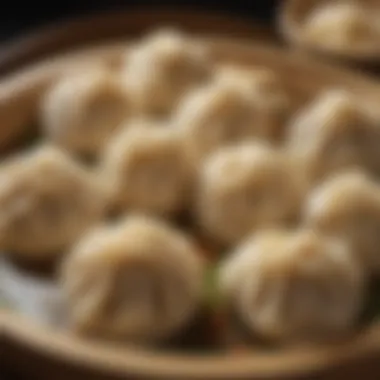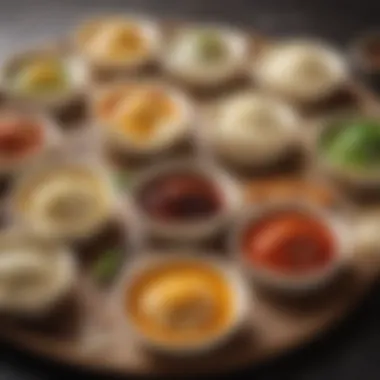Unveiling the Art of Chinese Soup Dumplings


Intro
Chinese soup dumplings, or xiaolongbao, are a culinary delight that many crave. Originating from the Jiangsu province, these steamed pockets are famous not just for their flavor but also for their intriguing method of preparation. The appeal of soup dumplings lies in their unique combination of a delicate outer skin and a savory broth sealed within. This exploration aims to uncover the local delicacies around this dish by examining its history, preparation methods, and tips to find the best restaurants.
Understanding the evolution of the soup dumpling offers insight into why it has gained popularity globally. In addition to this historical context, we will highlight the essential ingredients and cooking techniques that contribute to the perfect soup dumpling.
Throughout this guide, diners and enthusiasts alike will discover the important factors that determine quality, including the skill involved in folding the dumpling and the freshness of ingredients. With this knowledge, one can better appreciate the artistry behind these delightful morsels when dining out or even attempting to make them at home.
Foreword to Chinese Soup Dumplings
Chinese soup dumplings, known as "xiaolongbao," have garnered significant attention in the global culinary landscape. Understanding their origins, the evolution of their popularity, and the qualities that define an exceptional soup dumpling is crucial for any food enthusiast. This section sets the stage for exploring the delightful intricacies of this dish, which is celebrated for not just its flavor, but also its artistry in preparation.
The Origin of Soup Dumplings
Soup dumplings trace their roots back to Jiangsu province, with the city of Shanghai often highlighted as the birthplace of this delicacy. Historical accounts suggest that soup dumplings emerged in the late Qing Dynasty as a more portable form of a traditional dish. Initially, they were crafted by skilled artisans who invested time in perfecting the thin dough and savory broth within, which was a remarkable innovation at that time.
Over the years, various regions adapted this dish according to local ingredients and preferences. The method of encapsulating flavorful soup within a bite-sized dumpling changed the dining experience. The layering of flavors and textures defines why xiaolongbao has become a symbol of Chinese cuisine. The evolution from street food to a gourmet experience reflects broader social and economic changes in China and the diaspora.
Popularity of Soup Dumplings
The popularity of soup dumplings has soared, both in China and internationally. As the global appreciation for authentic Chinese food expands, soup dumplings have found their place in the hearts of many food lovers. They have become a must-try item in many Chinese restaurants around the world.
Social media and food blogs significantly contributed to their rise. Pictures of the delicate dumplings, complete with a tantalizing steam rising from their top, captivate audiences. Many people now seek out restaurants known for their authentic preparation, resulting in long lines and waitlists.
In addition to their visual appeal, soup dumplings represent a unique fusion of culinary techniques, showcasing the balance of flavors. Their widespread presence reflects changing dining habits, where food is not simply sustenance, but an experience to be shared and savored. However, it is essential to appreciate what elevates a good soup dumpling to an exceptional one, which is addressed in the following sections.
Characteristics of Quality Soup Dumplings
Understanding the characteristics of quality soup dumplings is essential for any enthusiast or casual eater looking for an authentic experience. These dumplings are more than just a meal; they represent a culinary tradition that requires skill and attention to detail. Evaluating these characteristics helps diners distinguish between average offerings and those that truly stand out.
Dough Texture and Thickness
The dough of a soup dumpling is a critical component that influences both its texture and the overall eating experience. A properly made dough will be thin yet strong enough to hold the soup and filling without tearing. This balance is vital because the dumpling needs to withstand the steaming process while maintaining integrity. The thickness should ideally be around one millimeter, allowing the dumpling to be delicate but not fragile.
It's important for the dough to have a smooth texture. When bitten into, it should yield easily, providing a pleasant mouthfeel. The texture can also affect the flavor absorption. Some chefs may even choose to use specific types of flour to achieve the desired elasticity and chewiness in the texture.
Broth Quality and Flavor
Quality broth is where soup dumplings truly shine. The broth should be rich, flavorful, and aromatic. It acts as the primary source of moisture and should complement the filling's flavors. A well-prepared broth often includes ingredients like chicken, pork, or seafood, simmered for several hours to capture the essence of the meats used. This meticulous process ensures that each dumpling is filled with juice that bursts in your mouth upon the first bite.
Flavor can be enhanced by incorporating spices or aromatics like ginger and scallions during broth preparation. A good broth will strike a harmonious balance between savory and slightly sweet notes, avoiding an overpowering flavor profile. Quality control in broth making is vital because it sets the tone for the entire dumpling experience.
Filling Ingredients
The filling of soup dumplings typically includes ground meat, most commonly pork, mixed with various seasonings. However, high-quality dumplings often incorporate additional elements, such as finely minced vegetables, seafood, or even different types of meat to create unique flavor profiles. Freshness of the ingredients is key here; stale or frozen meats can detract from the quality.
Balance in seasoning is essential. Not too salty, not too bland. A dash of soy sauce, ginger, or sesame oil can elevate the fillers, adding depth without overwhelming the natural tastes. Chefs sometimes also experiment with modern twists, introducing unusual ingredients like truffles or foie gras for a gourmet experience.
In summary, when indulging in soup dumplings, scrutinizing the dough, broth, and filling will aid in identifying superior quality. These aspects are intertwined, and their collaboration creates the distinctive sensory experience that has captured the hearts of many food lovers around the world.
Finding Soup Dumpling Restaurants Nearby


Finding a good place to savor soup dumplings is crucial for anyone interested in this delightful cuisine. Not only do soup dumplings offer a unique dining experience, but the quality can vary significantly from one restaurant to another. Consequently, knowing how to locate the best options in your area enhances not just the flavor, but the overall enjoyment of the meal. This section will explore different methods of discovering excellent soup dumpling spots, taking into account various resources and community recommendations.
Online Reviews and Recommendations
Online reviews have transformed the way diners choose their meal spots. Websites such as Yelp and TripAdvisor provide not only user reviews but also ratings based on various criteria. These reviews often contain detailed descriptions of the dumplings themselves, including textures and flavors, which can guide prospective diners.
Moreover, such platforms frequently feature photos from patrons, offering visual confirmation of quality.
Online recommendations can save you from disappointing dining experiences.
When reading reviews, it is insightful to look for mentions of key aspects such as broth richness, dough thickness, and overall flavor. Also, pay attention to responses from the restaurants themselves, as this indicates their commitment to customer satisfaction. Monitoring both positive and negative reviews allows for a more rounded understanding of potential dining venues.
Utilizing Food Apps and Guides
In the digital age, food apps are valuable tools for finding local delicacies. Applications like Zomato and Google Maps not only provide listings of nearby restaurants but also include user-generated content. You can easily explore ratings, menus, and location details.
Additionally, some of these apps curate lists based on popularity or special criteria. For instance, you might find "Top 10 Soup Dumpling Spots in Your Area". Using filters for cuisine type can also simplify your search significantly.
Another impressive feature of many apps is the ability to navigate through user-submitted photographs. These provide a window into the actual dining experience, often highlighting the appearance of the dumplings you might expect.
Local Food Blogs and Surveying Options
Local food blogs can be a treasure trove of information when it comes to soup dumplings. Many bloggers dedicate their content to exploring food scenes in their respective cities. They often provide in-depth reviews and personal experiences, which can be more insightful than traditional review sites.
Searching for posts featuring "soup dumplings" can unearth hidden gems in the local dining scene. Some bloggers even compile exhaustive guides that cover aspects from cooking styles to ambiance.
While exploring these blogs, consider looking at their social media pages on platforms like Facebook or Instagram. They might share real-time updates like popular dishes or special events happening at local restaurants.
Culinary Techniques in Soup Dumpling Preparation
In the realm of Chinese soup dumplings, culinary techniques are pivotal. They dictate the overall quality and enjoyment of the dish. Proper techniques can elevate a simple dumpling into a culinary masterpiece. Steps like gradual steaming, careful dough preparation, and precise broth consistency significantly impact the final product. Understanding these methods allows both chefs and enthusiasts to appreciate the subtleties behind every bite.
Steaming vs. Boiling
Steaming is typically preferred for cooking soup dumplings. This method helps to retain the delicate structure of the dumpling and ensures the broth inside remains intact. The steam gently circulates, allowing even cooking without compromising the filling's moisture. Boiling, while a common technique for other dumplings, can lead to ruptures in the skin, causing broth loss and diminished flavor.
- Benefits of Steaming:
- Maintains integrity of dumpling skin.
- Preserves flavorful broth appropriately.
- Enhances flavor by keeping ingredients moist.
Steaming is not just a cooking method; it’s an essential technique that defines the dumpling experience.
Texture Techniques for Dough
The texture of the dough is crucial in determining the dumpling's bite and experience. Quality soup dumpling dough needs to be thin yet resilient. This requires a careful balance in hydration and kneading. Water temperature also plays a role. Hot water results in a pliable dough, while cold water provides a firmer texture. During preparation, stretching the dough rather than rolling it helps in achieving that desired thinness without excessive pressure that could cause tearing.
- Tips for Perfect Dough:
- Use high-gluten flour for elasticity.
- Rest the dough adequately to allow gluten formation.
- Keep a consistent thickness throughout.
Consistency in Broth Making
The broth is the heart of the soup dumpling. Its richness and flavor are essential to the dish's satisfaction. Achieving the perfect broth requires a balance of ingredients and careful simmering. Bones, meat, and aromatics should simmer well to infuse flavors thoroughly. The cooling process is also critical. When broth is cooled, it becomes gel-like. This gelatinous state is what creates the delightful, warm liquid experience when the dumpling is bitten into.


- Essentials for broth consistency:
- Use quality bones and fresh meats.
- Slow cooking extracts maximum flavor.
- Strain the broth to remove impurities and ensure clarity.
In summary, the techniques employed in soup dumpling preparation are multifaceted. They require precision and care at every stage, from steaming methods to dough crafting and broth preparation. Understanding these processes enriches one's appreciation for this local delicacy. The subtleties in each step contribute to a greater dining experience that goes beyond mere consumption.
Regional Variations of Soup Dumplings
Understanding the regional variations of Chinese soup dumplings is essential for appreciating their diverse flavors and textures. These variations offer a glimpse into the culinary practices and local ingredients that define different regions in China. Each style brings a unique twist to this beloved dish, enhancing its appeal and inviting food lovers to explore further.
Shanghai Style Soup Dumplings
Shanghai soup dumplings, also known as xiao long bao, take center stage in the world of dumplings. They are characterized by their thin, delicate skin, which is crucial to the overall experience. The filling typically consists of seasoned pork combined with savory broth, which creates a juicy explosion when bitten into. The mastery of crafting xiao long bao lies in the balance of dough thickness and the quality of the broth.
Moreover, traditional Shanghai soup dumplings are steamed in small baskets, allowing for even cooking. They are often served with a side of ginger and soy sauce for dipping. The cultural importance of these dumplings is enormous, being a staple in local cuisine and favored by locals and tourists alike.
Taiwanese Variations and Innovations
Taiwanese soup dumplings present an innovative take on the traditional recipe. While still maintaining the essence of xiao long bao, Taiwanese chefs often experiment with fillings such as crab meat, chicken, or even vegan options. This creativity allows for a broader palate that appeals to diverse tastes.
In Taiwan, diners can also find gourmet varieties that introduce rich, distinct flavors like garlic or truffle oil. The Taiwanese method also often involves modifying the boiling technique, sometimes incorporating deep-frying for a different texture. This adaptability has solidified the status of Taiwanese soup dumplings as a must-try for those seeking exciting culinary experiences.
Other Regional Adaptations
Beyond Shanghai and Taiwan, several regions have their own adaptations of soup dumplings. For example, the Wuxi style dumplings are slightly sweeter, often featuring a mixture of pork with a touch of sugar and soy sauce, creating a more complex flavor profile. In contrast, Beijing offers dumplings filled with rich meats, making them heartier and appealing for colder climates.
In northern regions, dumpling skins may be thicker to hold more substantial fillings, while southern varieties focus on finesse and broth concentration. Understanding these local adaptations not only enriches one's culinary knowledge but also enhances the overall dining experience, as one appreciates the nuances and traditions behind each variant.
"Soup dumplings are not just food; they are a cultural narrative wrapped in dough."
Exploring these regional distinctions allows food enthusiasts to broaden their culinary horizons, ensuring every visit to a restaurant serves as an opportunity for new discoveries.
Enhancing the Dining Experience with Soup Dumplings
Enhancing the dining experience when enjoying soup dumplings goes beyond just the dish itself. This culinary delight can be paired with various elements that elevate the meal and provide a richer tasting adventure. Understanding the accompanying components, such as sauces and proper beverage pairings, can deeply influence how one perceives the flavors and textures of soup dumplings. Choosing the right additions not only boosts the enjoyment of these delicate parcels but also allows for greater appreciation of the craft behind their creation.
Ideal Dipping Sauces
Dipping sauces play a significant role in the overall enjoyment of soup dumplings. The right sauce brings out the authentic flavors and enhances the experience. The most common sauce served is a mixture of soy sauce, vinegar, and a hint of chili oil. This combination provides a balance of salty, tangy, and spicy notes that complement the savory broth and filling of the dumplings. Here are some popular sauces to consider:
- Soy Sauce: The base for many dipping sauces, it adds a salty depth.
- Black Vinegar: Sharp and fragrant, it cuts through the richness of the dumpling filling.
- Chili Oil: Adds heat and complexity, useful for those who enjoy a spice.
- Ginger and Scallion Mix: Fresh and aromatic, this blend brightens the experience.
While there are many variations, it is essential to experiment to find the combination that fits your palate. Each region might offer its unique sauce, enhancing the traditional soup dumpling experience.
Pairing Suggestions with Beverages
The choice of beverage can enhance the flavors of soup dumplings significantly. Pairing the right drink with your meal not only complements the dish but also elevates your overall dining experience. Here are several suggestions that work well:
- Jasmine Tea: Its floral notes refresh the palate between bites.
- Chardonnay: A lightly oaked white wine can match the richness of the dumplings.
- Tsingtao Beer: This lager's crispness cleanses the palate and balances the dumpling's savory nature.
- Bubble Tea: Especially popular in Taiwan, it adds a playful touch with its unique textures.
Choosing the right beverage helps create a harmonious balance with the flavors of the soup dumpling. It’s worth considering personal preference and how each drink interacts with the dish’s ingredients.


Common Mistakes When Eating Soup Dumplings
Understanding common mistakes when enjoying soup dumplings is key to enhancing one’s dining experience. These errors can significantly impact the overall enjoyment of this dish. A poorly executed bite may lead to an unappetizing experience, deterring diners from savoring authentic flavors. Awareness of these missteps not only boosts individual appreciation but also supports the restaurant culture, ensuring the quality and integrity of this delicacy are maintained. Knowledge of proper techniques can therefore transform an ordinary meal into an extraordinary culinary experience.
Handling and Serving Techniques
One significant area where diners often falter involves the handling and serving of soup dumplings. These delicate delights require specific methods to ensure an optimal experience. First, it is essential to use a spoon when picking them up, as chopsticks may cause the fragile dumpling to burst. A wide spoon is recommended to cradle the dumpling.
Additionally, avoid using excessive force when transporting soup dumplings from the plate to your mouth. A gentle lift helps preserve the broth within the dumpling, preventing spillage. Placing your dumpling gently onto your spoon can also safeguard against accidental tearing. Thus, proper handling techniques can greatly enhance enjoyment and prevent messiness.
Misjudging Cook Times
Misjudging cook times can easily ruin the soup dumpling experience. Both undercooked and overcooked dumplings have serious drawbacks. Under cooking leaves the dough chewy and the filling cold, resulting in a failure to capture the intended flavors. Conversely, overcooked dumplings may cause the broth to evaporate, and the dough can become unpleasantly soft.
It is important to pay attention to the size and type of dumpling being cooked. For example, larger soup dumplings will naturally take longer to cook than their smaller counterparts. Observing cooking recommendations provided by restaurants can also aid in ensuring that dumplings maintain their ideal texture and flavor. A careful consideration of cooking times ultimately enhances the dining experience: diners are likely to enjoy the authentic taste and texture of soup dumplings when these details are adequately respected.
Sampling Different Varieties
Sampling different varieties of soup dumplings is essential for appreciating the culinary diversity within this dish. Each region offers unique flavors and textures, which can significantly differ. Understanding these variations not only enhances the dining experience but also deepens one’s appreciation for the culinary art involved in making soup dumplings. By trying different types, one can uncover the rich tapestry of ingredients and techniques that contribute to this beloved dish.
Organizing a Dumpling Tasting
To truly experience the range of soup dumplings available, consider organizing a dumpling tasting event. Here are steps to guide you:
- Select a Variety of Restaurants: Choose establishments known for their dumplings, ensuring a mix of regional styles like Shanghai or Taiwanese.
- Prepare the Right Environment: Set up a comfortable space where everyone can gather. A large table with adequate seating is ideal.
- Gather Friends or Family: Invite food enthusiasts to join you. A group adds to the enjoyment and allows for more dumplings to sample.
- Plan the Menu: Decide on a selection of dumplings, possibly including different fillings like pork, crab, or veggie variations. This creates a spectrum of flavors.
- Arrange for Dipping Sauces: Having a range of sauces enhances the tasting—soy sauce, vinegar, and chili oil are excellent choices.
- Document Each Variety: Provide scorecards or paper for notes. This encourages conversation and comparisons.
Tasting different dumpling varieties allows you to discuss nuances in fillings, broth flavor, and dough texture as you enjoy the meal together.
Analyzing Flavor Profiles
To fully appreciate soup dumplings, one should analyze their flavor profiles methodically. Here are factors to consider:
- Filling Ingredients: The main protein, whether it's pork or crab, significantly influences the overall taste. Notably, seasoning can vary from restaurant to restaurant.
- Broth: This often overlooked element can be the star of the show. Assess the richness, temperature, and how well it complements the filling.
- Dough Quality: The balance of softness and thickness in the dough plays an integral role. It should not overpower the filling.
- Dipping Sauces: These can dramatically change the perception of flavor. Consider how the salty or spicy elements interact with the dumpling's natural taste.
"Exploration of flavors is an art form. Each tasting is a chapter in the story of the dish."
In summary, engaging with the flavor profiles of various soup dumplings provides insights into their preparation and highlights the care that goes into crafting each variety. This appreciation transforms a simple meal into a gastronomic adventure.
End and Recommendations
The conclusion of this article serves as a vital component in wrapping up the intricate exploration of Chinese soup dumplings. It synthesizes the key insights drawn from the various sections. Recognizing the nuances in flavor and texture, discerning diners can enhance their eating experience. By reflecting on the culinary principles that define high-quality soup dumplings, one also gains an appreciation for the craftsmanship involved in their creation.
Reflecting on the Experience
To truly value the journey of tasting soup dumplings, it is essential to reflect on one's experiences. Each bowl presents a unique narrative shaped by regional influences and individual preparation methods. Asking questions such as:
- What specific flavors stood out?
- How did the texture of the dough impact the overall taste?
- Were the dipping sauces complementary, or did they overwhelm the dumpling's natural flavors?
Thinking about these points can deepen one’s understanding and enjoyment. Familiar tastes become more significant when contrasted against new experiences. This act of reflection brings insight, enabling diners to articulate their preferences better and seek out new variations in the future.
Future Discoveries to Consider
As the exploration of soup dumplings continues, many avenues remain open for culinary adventure. Local restaurants may introduce seasonal fillings or innovate with ingredients that challenge traditional boundaries. Enthusiasts should consider:
- Joining local food tours to discover hidden gems that offer unique varieties.
- Experimenting with making soup dumplings at home, following traditional recipes or even creating new fillings.
- Engaging with online communities, such as those found on platforms like Reddit or specialized Facebook groups. These communities often share recommendations and recipes that can reveal lesser-known dumpling styles.
Future discoveries may lead to unexpected culinary delights. Being open to trying diverse variations will enrich your appreciation of soup dumplings and contribute to a deeper understanding of this beloved dish.















